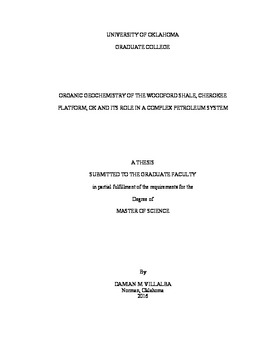| dc.description.abstract | The Woodford Shale is probably the most prolific source rock in the Anadarko Basin and Cherokee Platform. During the last decade, it became more important due to its high unconventional hydrocarbon potential. Recent studies have emphasized the facies heterogeneity from lithology, sequence stratigraphy, and geochemistry analyses. Therefore, this project focuses on the organic geochemistry description of the Woodford Shale and oils, and their genetic relationship. The primary objective is to describe the depositional environment during sedimentation and its further association with the oils in place in the surrounding area of the Cherokee Platform. The first set of samples corresponds to the Woodford Shale obtained from a vertical core from a vertical well in the southeastern Pottawatomie County.
The rock samples were characterized through screening techniques, total organic carbon (TOC) and Rock-Eval (RE), and suggested organic-rich black and grey highly oil/gas prone shale. The oxygen and hydrogen index from RE suggest a high-quality kerogen, between Type I and II. The vitrinite reflectance measurement VR (%) indicates early maturity stage of 0.59%. The TOC values range from 4 to 13%, with an average of 9 to 10%. The HI was also high, from 470 to 560 mg HC/g TOC, and the OI low, not higher than 10 mg HC/g TOC.
The Woodford Shale is subdivided into three members (Upper, Middle, and Lower), but in this study, only the Upper and the top part of the Middle Woodford were analyzed. Both intervals have shown alternation between suboxic and anoxic depositional conditions, along with water column stratification and episodic euxinia or anoxia photic zones (PZA). As a novelty, a new persistent PZA episode has been described for Upper Woodford, where C40 carotenoids and aryl isoprenoids have shown maximum abundance.
The second part of the investigation involved oils collected from different wells in the area and a detailed correlation with the Woodford Shale to determine if this was the source of the oils. The Ray 1-13 oil showed close correlation with the Woodford itself where it is being produced as a tight oil, but maturity based on biomarkers may suggest a deeper source rock with equivalent organofacies. In addition, the Ray 1-13 oil has shown biodegradation signals and possibly a condensate mixture.
Additionally, the Pottawatomie oils were compared with each other in order to find possible groups and to assess the petroleum system on the southwestern Cherokee Platform. In general, the oils show very similar fingerprinting and correlate within each other and with the Woodford Shale and based on biodegradation two groups are proposed. Lastly, most of the oils also show traces of being commingled by a condensate oil type, due to light hydrocarbons enrichment. | en_US |
